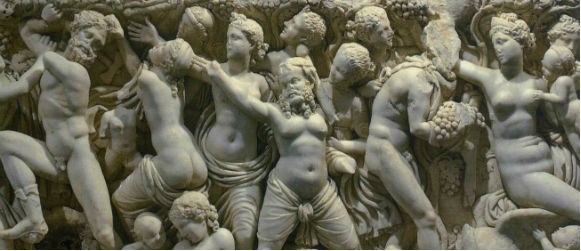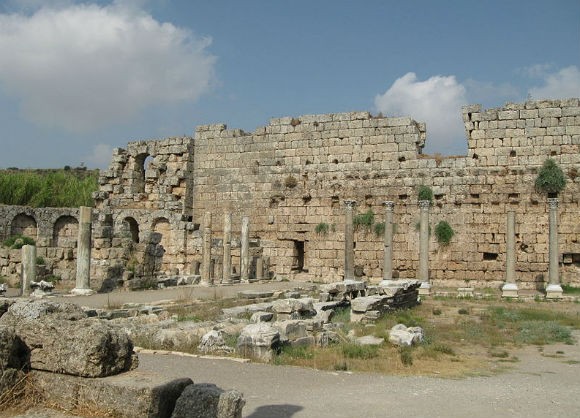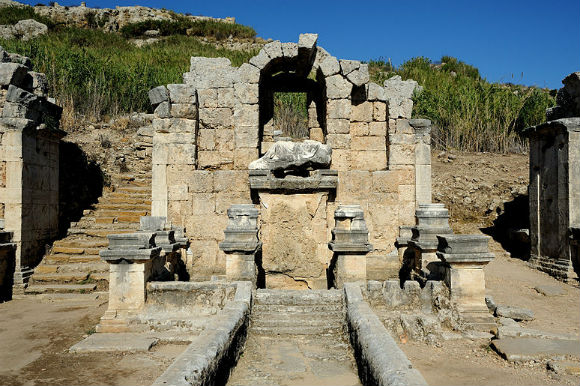Perga was an old city even in the first century. Its name (which is not Greek) indicates that its origin dates from pre-Greek times. Alexander the Great passed through it twice while the Pergaeans offered no resistance to him although it was a walled city with a citadel. In Roman times the main streets were over twenty-one meters wide. They were lined with Ionic colonnades and a water channel ran down their center in a series of small waterfalls as in Antalya today. Behind the colonnades stood the shops. Of the early buildings the stadium and the theater have survived the ravages of earthquakes and wars with the least damage. In fact this stadium which could seat about fourteen thousand people is one of the best preserved in Turkey.
The temple of the Pergaean Artemis according to a writer of the time was “a marvel of size, beauty, and workmanship.” Its location has yet to be established; it may have been where there are now ruins of a Byzantine church on a hill to the southeast of the city.
Perga is on a rise not far from the Cestrus River which was navigable In Paul’s time. It was not a seaport in terms of Its being directly on the Mediterranean even then, but rather it was more easily defended where it was: its distance from the open sea made it less vulnerable to piracy.
Two people stand out among the early residents of Perga. Apollonius was a third century B.C. astronomer and mathematician who believed that the movements of heavenly bodies in the universe were explainable by orbits within orbits: that the moon went around the earth as the earth went around the sun. He was much ahead of his time in his theories of astronomy, so much so that the ideas had to be rediscovered during the Renaissance. Plancia Magna was unusual for a second century A.D. woman: she held the highest city office during her life, that of demiurgus. She must have been well-to-do for a number of inscriptions record her gifts to the city.
Paul and Barnabas went through Perga on their way to and from Antioch on their first journey (Acts 13:13, 14:25). John Mark was with them at first but left them at Perga to return to Jerusalem. The reason for that must have been such that Paul doubted his commitment to the cause. Later when Paul and Barnabas were about to start on their second journey from Antioch they had a sharp dispute over his worthiness. Paul refused to have him go along, so John and Barnabas went to Cyprus while Paul chose Silas to accompany him.
Paul talks in II Corinthians 12:7 and in Galatians 4:13-14 of bodily illness that brought him to Galatia the first time. It may have been on that account that he did not stay long in Perga the first time. Whatever the illness was, it seems to have improved in time in the dry mountain air to the north.
The second theory of why they did not stay long in Perga is that their interview with Sergius Paulus, the proconsul of Cyprus, had made them want to hurry to the Roman colony in Antioch of Pisidia. This interpretation may lay too much stress on the lasting importance of that meeting with a cultured Roman who could have been more interested in the pursuits of the mind than the salvation, in Christian terms, of his soul. It is interesting, however, that this is” the point in Acts (13:9) that Luke begins to call Paul by his Roman name, not his Jewish “Saul”.
On their return they did stay in Perga long enough to preach and talk with people there. Nothing else is told about the city or their time there.
Perga,






We were very impressed by this site. The extent of the ruins is quite unexpected with large areas still to be uncovered.
Well preserved baths were great! Columns impressive. It is very hot, bring water and sunscreen. Bargain with vendors…be careful they give you change. Well worth a visit.
very interesting place. We had a terrific guide who was passionate about his subject. Shows that there was civilisation before the romans.
if you enjoying amazing architual remains of a roman city then vist Perge a wonderfull example be sure to take a hat and water it did get very hot hardley any shade about
A large site which has been extensively excavated. There is an enormous stadium which has collapsed like a pack of cards and a theatre ( no current access) which looks impressive from outside. If you visit this site, you must also go to the Antalya Archaeological Museum where many of the statues recovered from the site are displayed. Entrance admission…
Like most of the major archaeological sites in Turkey, Perge is somewhat hidden away but easy to access. The heat is intensive – there is not much cover and no opportunity for drinks or snacks once you enter the site itself. The site is massive with huge amounts of remains. You don't have to visualise what it would have looked…
I think Perge is a must-see if you are at Turkey. But be warned – the weather can be killing if you go in summer like what I did. But I should not complain because the pictures taken on such days are beautiful.
A must-see for people that love history and appreciate ancient ruins.
My only complaint was the travel…
Love the history behind the visit, very well preserved. On a hot day make sure you have plenty of water to drink when walking around the site.
I visited in March 2011 and was in the area primarily to visit the theater at Aspendos. Outside of the theater there, the ruins don't provide a very good picture of how a city looked in the Roman/Greek era. Perge provides much better ruins on a whole and a good view into the way of life then.
There are certainly…
Every bit of the place is filled with history!!!
There are many reconstructed , interesting objects for sightseeing.
It's a must to visit in Turkey.